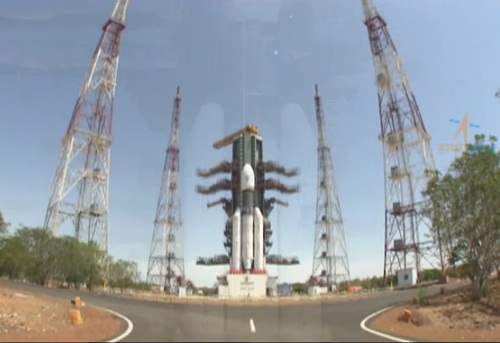The Indian Space Research Organisation (Isro) today successfully launched the GSAT-29 communication satellite, onboard its heavy lift rocket the Geosynchronous Satellite Launch Vehicle (GSLV-Mk III), which will help India solve the communication barriers in the hinterlands.
The GSAT-29 aims at solving the communication problem faced by Village Resource Centres (VRCs) that are responsible for providing space-based services to Isro from rural areas.
GSLV Mark III, India’s heaviest rocket so far, lifted off with the 3,423 kg communications satellite from the Satish Dhawan Space Centre in Sriharikota in the evening today, defying earlier speculation of delay in the launch due to cyclone ‘Gaja’, which is expected to cross the Tamil Nadu coast on 15 November.
The GSAT-29 is designed for a mission life of 10 years and will also serve as a test-bed for several new technologies in providing latest communication technologies.
“The GSAT-29 carries Ka/Ku-band high throughput communication transponders intended to meet the communication requirements of users including those in remote areas. In addition, several new technologies such as Q/V-band payload, data transmission through optical communication link will be demonstrated in this programme. This will help in realising future advanced satellites.”
GSLV MkIII-D2 lifted off from the Second Launch Pad of SDSC SHAR at 17:08 hours (IST), carrying the 3423-kg GSAT-29 satellite. About 17 minutes later, the vehicle injected the satellite into the Geosynchronous Transfer Orbit (GTO) as planned, Isro said.
After injection, ISRO’s Master Control Facility at Hassan assumed the control of the satellite. In the coming days, Isro will carry out three orbit raising manoeuvers to position the satellite in the geostationary orbit at its designated location.
GSLV Mk III is a three-stage heavy lift launch vehicle developed by the Indian Space Research Organisation (ISRO).
Two massive boosters with solid propellant constitute the first stage, the core with liquid propellant form the second stage and the cryogenic engine completes the final stage.
GSAT-29 is a multiband, multi-beam communication satellite, intended to serve as test bed for several new and critical technologies. Its Ku-band and Ka-band payloads are configured to cater to the communication requirements of users, including those from remote areas especially from Jammu & Kashmir and North-Eastern regions of India.
In addition, the Q/V-Band communication payload onboard is intended to demonstrate the future high throughput satellite system technologies. Geo High Resolution Camera will carry out high resolution imaging. Optical Communication Payload will demonstrate data transmission at a very high rate through optical communication link.
“India has achieved significant milestone with our heaviest launcher lifting off the heaviest satellite from the Indian soil. The launch vehicle has precisely placed the satellite in its intended orbit. I congratulate entire ISRO team for this achievement,” Isro chairman K Sivan said after the successful launch.
Declaring GSLV MKIII operational, Sivan announced that Chandrayaan-2 and Gaganyaan missions will be launched by this heavy-lifter.
Jayakumar B, Mission Director, GSLV Mark III said it is the guidance of the mentors at Isro that helped the team to march ahead while facing obstacles. “The industry partners too played a key role in this mission,” he said.
K Pankaj Damodar, Project Director, GSAT-29, said the launch will help to bridge the digital divide. He also said several next generation payload technologies will be demonstrated with this mission soon.
The success of GSLV MkIII-D2 marks an important milestone in Indian space programme towards achieving self-reliance in launching heavier satellites. The success of this flight also signifies the completion of the experimental phase of GSLV Mark III.
The first successful mission of GSLV Mark III was an experimental suborbital flight in 2014. Subsequently, GSLV Mark III-D1 launched GSAT-19, a high throughput communication satellite, with a lift-off mass of 3150 kg, into GTO on June 5, 2017.














.jpg)






.jpg)









